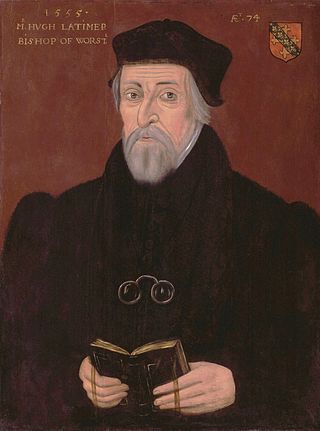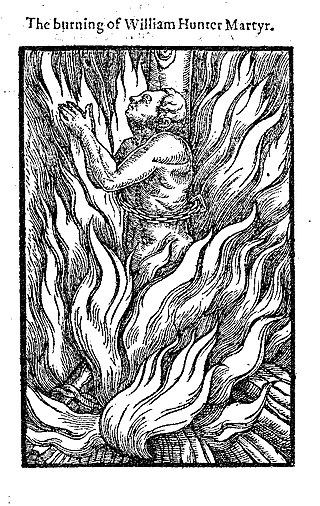
Hugh Latimer was a Fellow of Clare College, Cambridge, and Bishop of Worcester during the Reformation, and later Church of England chaplain to King Edward VI. In 1555 under the Catholic Queen Mary I he was burned at the stake, becoming one of the three Oxford Martyrs of Anglicanism.

William Hunter was a Marian martyr burnt to death in Brentwood, England at the age of 19 on 26 March 1555, on Ingrave Road. He had lost his job in London as a silk-weaver because he refused to attend the Catholic mass, despite an order that everyone in the City of London had to attend, and had come to live with his parents in Brentwood, but got into a dispute when discovered reading the Bible for himself in Brentwood Chapel. He refused to accept the Catholic dogma of transubstantiation according to which the bread and wine of the communion become the body and blood of Jesus.

Rowland Taylor was an English Protestant martyr during the Marian Persecutions.
The Ipswich Martyrs were nine people burnt at the stake for their Lollard or Protestant beliefs around 1515-1558. The executions were mainly carried out in the centre of Ipswich, Suffolk on The Cornhill, the square in front of Ipswich Town Hall. At that time the remains of the medieval church of St Mildred were used for the town's Moot Hall. Later, in 1645 Widow Lakeland was executed on the same site on the orders of Matthew Hopkins, the notorious Witchfinder General.

The Oxford Martyrs were Protestants tried for heresy in 1555 and burnt at the stake in Oxford, England, for their religious beliefs and teachings, during the Marian persecution in England.

George Marsh was an English Protestant martyr who died in Boughton, Chester, on 24 April 1555 as a result of the Marian Persecutions carried out against Protestant Reformers and other dissenters during the reign of Mary I of England. His death is recorded in Foxe's Book of Martyrs.

The French Protestant Church of Brighton is a former place of worship in the English city of Brighton and Hove. Until its closure in 2008, it was the only French Protestant church in Britain outside London, where the French Protestant Church of London, founded in 1550, occupies a building dating from 1893 in Soho Square. Brighton's dates from the previous decade, and is centrally located in Queensbury Mews, a small street just behind Brighton seafront and next to the Metropole Hotel. Opened in 1887, it was put up for sale in June 2008 and was closed a month later.

Richard Woodman was a Protestant martyr, who was born in Buxted and lived in nearby Warbleton in East Sussex. He was burnt during the Marian Persecutions in 1557 in Lewes. The cult of the Sussex Martyrs is said to have been started using an etching by James Henry Hurdis of Woodman burning as a Protestant martyr.

The Coventry Martyrs were a disparate group of Lollard Christians executed for their beliefs in Coventry between 1512 and 1522 and in 1555. Eleven of them are commemorated by a six-metre-high (20 ft) monument, erected in 1910 in a public garden in the city, between Little Park Street and Mile Lane; and by a mosaic constructed in 1953 inside the entrance to Broadgate House in the city centre. Some of the streets in the city's Cheylesmore suburb are named after them.

Thomas Hawkes was an English protestant martyr who burned to death in 1555 during the Marian Persecutions rather than allow his son to be baptised into the Roman Catholic Church.
The Canterbury Martyrs were 16th-century English Protestant martyrs. They were executed for heresy in Canterbury, Kent and were the last Protestants burnt during the reign of Mary I. Their story is recorded in Foxe's Book of Martyrs.
Bartholomew or Bartlet Green, was an English Protestant.

The Lewes Martyrs were a group of 17 Protestants who were burned at the stake in Lewes, Sussex, England, between 1555 and 1557. These executions were part of the Marian persecutions of Protestants during the reign of Mary I.

The Stratford Martyrs were eleven men and two women who were burned at the stake together for their Protestant beliefs, either at Stratford-le-Bow, Middlesex or Stratford, Essex, both near London, on 27 June 1556 during the Marian persecutions.
Religion in Sussex has been dominated over the last 1,400 years by Christianity. Like the rest of England, the established church in Sussex is the Church of England, although other Christian traditions exist. After Christianity, the religion with the most adherents is Islam, followed by Hinduism, Buddhism, Judaism and Sikhism.
The history of Christianity in Sussex includes all aspects of the Christianity in the region that is now Sussex from its introduction to the present day. Christianity is the most commonly practised religion in Sussex.

The Stratford Martyrs Memorial is a memorial that commemorates the group of 11 men and two women who were burned at the stake together for their Protestant beliefs, at Stratford-le-Bow or Stratford near London in England on 27 June 1556, during the Marian persecutions.

John Launder (1530–1555) was an English Protestant martyr. He was executed in 1555 during a period of religious persecutions in England.













